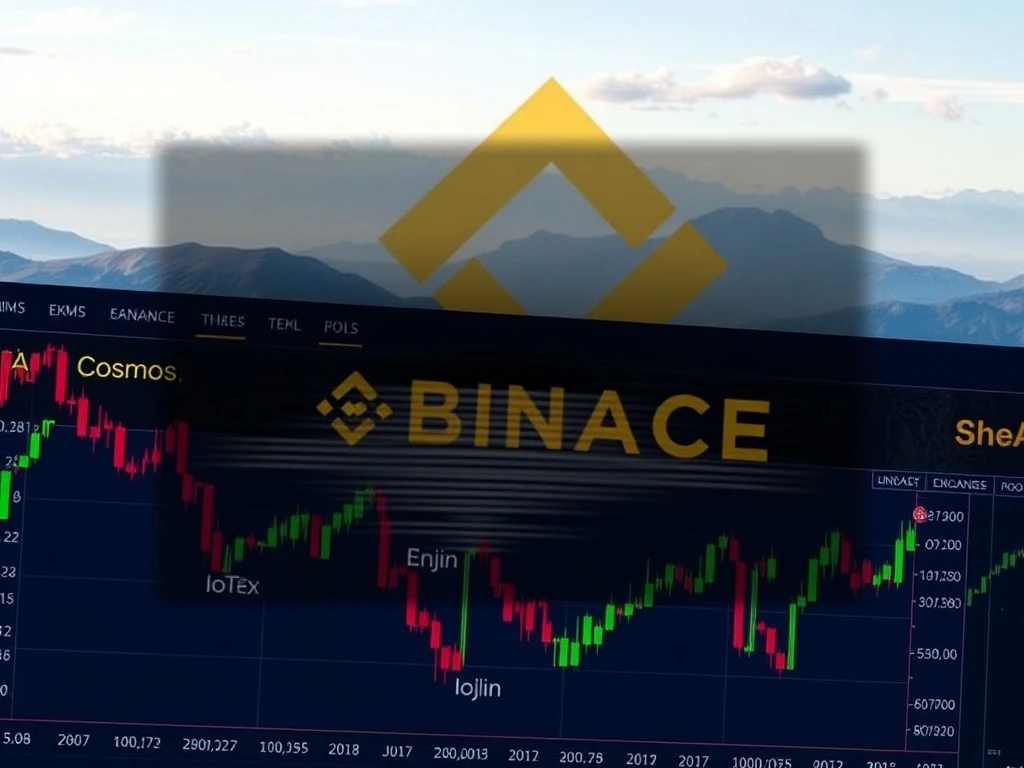Urgent: Binance Display Issue Causes Altcoin Prices Zero Panic Amidst Crypto Market Crash

The cryptocurrency market often experiences volatility. Recently, however, a specific incident on Binance sparked widespread alarm. Many users witnessed their **altcoin prices zero** on the platform, leading to immediate panic. Binance swiftly addressed these concerns. The exchange clarified that a ‘display issue’ was responsible for the alarming visuals, not an actual crash to zero. This article delves into the details of this critical event, examining Binance’s explanation, the broader market context, and the theories surrounding a potential coordinated attack.
Understanding the Binance Display Issue
On a turbulent Friday, numerous altcoins on Binance seemingly crashed to negligible values. Users reported seeing tokens like IoTeX (IOTX), Cosmos (ATOM), and Enjin (ENJ) plummet to what appeared to be $0. This visual discrepancy created significant distress among traders. However, these tokens maintained their actual value on other centralized exchanges. Binance quickly moved to reassure its users. The exchange stated that the tokens did not, in fact, lose all their value. Instead, a technical glitch caused the erroneous display.
Binance provided a detailed explanation for this peculiar occurrence. “Certain trading pairs, such as IOTX/USDT, recently reduced the number of decimal places allowed for minimum price movement,” Binance announced. Consequently, this change affected how prices appeared in the user interface. The system displayed prices as zero, which was purely a visual bug. This technicality meant users saw a $0 price, but the underlying assets retained their true market value. Thus, the perceived crash was a display anomaly, not a fundamental asset devaluation.
The Broader Crypto Market Crash Context
This **Binance display issue** unfolded against a backdrop of severe market turmoil. Friday’s market meltdown triggered liquidations totaling up to $20 billion. This figure marks the worst 24-hour crypto liquidation event in market history. Such significant market movements naturally heighten investor anxiety. Therefore, any perceived malfunction on a major exchange like Binance can amplify panic. The incident underscored the fragility of market sentiment. It also highlighted the critical need for transparent communication from exchanges during volatile periods. Understanding the wider context helps explain the intense user reaction to the ‘display issue’.
The USDe Depeg and Coordinated Attack Speculation
Adding another layer of complexity, speculation arose about a potential coordinated attack. Crypto trader ElonTrades theorized that Binance might have been the target of a malicious exploit. This exploit, he suggested, caused Ethena’s USDe synthetic dollar to lose its dollar peg. The **USDe depeg** saw its value drop to $0.65 on Binance. ElonTrades pointed to Binance’s “Unified Account” feature. This feature uses oracle data from internal order books, not external ones. This design choice, he argued, created a vulnerability. Attackers could exploit this mechanism to create major price discrepancies.
Binance had previously announced plans to fix this by sourcing price feeds from external oracles. The deadline for this fix was October 14. ElonTrades theorized that threat actors exploited this window of opportunity. This alleged exploit sparked a cascade of liquidations. These liquidations reached up to $1 billion on Binance alone. Subsequently, this incident contributed to a broader market contagion. The theory, while speculative, highlights the ongoing security challenges faced by centralized exchanges.
Binance Compensation and Industry Reactions
In response to the market chaos and the **USDe depeg**, Binance announced substantial compensation. The exchange committed a total of $283 million to victims. This compensation targets users who suffered liquidations directly resulting from the depegging event. This move aims to restore user confidence and mitigate losses. However, the incident also drew criticism from other industry leaders. Kris Marszalek, CEO of rival exchange Crypto.Com, called for regulatory investigations. He urged scrutiny of centralized exchanges that experienced heavy losses during Friday’s historic market crash. This sentiment underscores a growing demand for greater oversight and accountability within the crypto space. The calls for regulation often intensify following major market disruptions, pushing for stronger protective measures for investors.
Ensuring Trust Amidst Volatility: Lessons from the Crypto Market Crash
The recent events serve as a stark reminder of the inherent risks in cryptocurrency trading. While the **Binance display issue** was a technical glitch, it exposed deeper concerns. User trust remains paramount for any exchange. Transparency and rapid communication are crucial during market volatility. Exchanges must continually enhance their security protocols. They also need to ensure the integrity of their price feeds. The incident also highlighted the importance of robust risk management for individual traders. Diversifying assets and understanding exchange mechanisms can help mitigate potential losses. As the crypto market matures, incidents like these drive continuous improvement. They push for greater resilience and reliability across the ecosystem. Ultimately, fostering a secure and trustworthy environment benefits all participants in the digital asset space.
The events surrounding the perceived **altcoin prices zero** on Binance offer valuable lessons. Exchanges must prioritize clear communication and technical robustness. Users, in turn, must remain vigilant and informed. The path forward involves collective efforts to build a more secure and transparent cryptocurrency landscape. This includes continuous dialogue between exchanges, regulators, and the trading community. Such collaboration will strengthen the entire industry against future challenges and maintain investor confidence.










